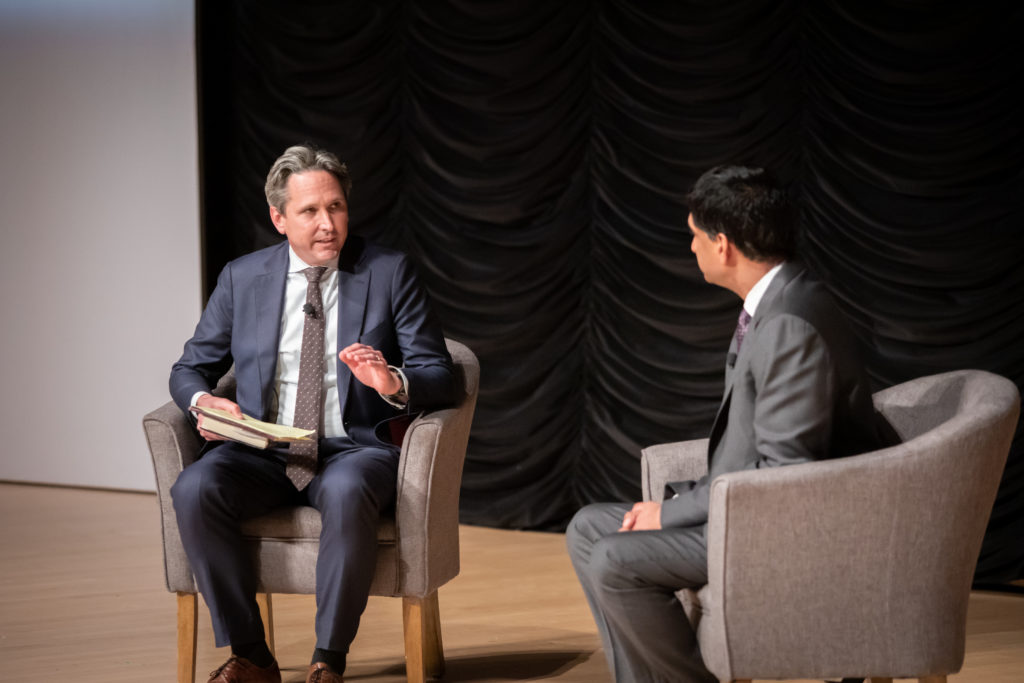Silicon Valley’s Congressman Calls for ‘Dignity in a Digital Age’


What does dignity mean to Ro Khanna, the Silicon Valley member of Congress and author of the new book, Dignity in a Digital Age: Making Tech Work for All of Us? “Dignity means respect for someone, their agency, their ability to do things, to lead fulfilling lives,” he believes. It also relates deeply to economic security and citizenship: “In an economic sense … it’s about giving people agency, how they’re going to be economic actors and build wealth in this digital age.” As for citizenship, “A robust public sphere shouldn’t be just talk for the sake of talk, it has to influence government action.”
Khanna joined Brian Bennett, the senior White House correspondent for Time magazine, at From Day One’s May conference in Washington, D.C., to offer a vision for democratizing digital innovation, empowering workers, and embracing a new kind of “progressive capitalism” to build economically vibrant and inclusive communities. Much of that argument is woven into his new book, which imagines how the digital economy can create opportunities for people across the country without uprooting them.
Throughout the conversation, Khanna broke down the different ways that “globalization has not worked, modernization of the economy has not worked” for people outside his district of Silicon Valley. His book points out that of the 25 million digital jobs that now exist, 90% are concentrated in five cities.
Not only has this contributed to intensified economic inequality, the dominance of tech and social media–alongside the lack of representative governance–has threatened democracy and public discourse. “One of the reasons I think people are on Facebook and Twitter is almost a disempowerment, because they think it’s the only way they’ll get attention,” he said. “A robust democracy requires citizen opinion that shapes government action, and I’d argue that link is broken and people know it’s broken.”

Khanna offers solutions to repair this broken link, starting with regulation in the tech industry. “It can’t be just left to tech companies, there needs to be regulation,” he said, including laws around privacy and antitrust. “We need to have rules of the road, which have been critical in the broadcast space and the media space that’s allowed journalistic ethics to emerge.”
With regulations in place, he believes that tech leadership must “have a responsibility of what the mission of the social-media company is, and then think critically about the guidelines, what we’re trying to achieve, and our responsibility to democracy.”
To provide more economic opportunity, he called for better alignment between the tech industry, government and education. “How can government support people in doing this, and how can the educational institutions design curriculum with the private sector?” he asked. Khanna pointed to a Google pilot program at Carl Sandburg College, in which the company will pay students $5,000 to take an 18-month course, which includes a mentor from the company and will result in being hired for a well-paying job. “There’s no reason we couldn’t scale that if we got the land-grant institutions, HBCUs, government and the private sector saying, How we could get 1 million folks preparing for these digital jobs?”
Tech companies also must be more intentional in diversity, equity, and inclusion efforts. “You can’t outsource the responsibility of diversity as a CEO or as a leader,” Khanna said. “You have to have that tied to a CEO’s performance and metrics.” In bringing back women to the workforce after the pandemic-induced child care crisis, for example, he listed initiatives like flexible workplaces, child care benefits and paid family leave: “We need to rethink work.”
Wrapping up the conversation, Khanna took the long view about society’s adjustment to the digital age, pointing out that the printing press also caused great societal upheaval. It took about 100 years to build institutions around it, leading it to become widely seen as a public good. “Social media has just started,” he said. “We need to do a lot more to build the digital institutions to get us to that place.”
Emily Nonko is a Brooklyn, NY-based reporter who writes about real estate, architecture, urbanism and design. Her work has appeared in the Wall Street Journal, New York magazine, Curbed and other publications.
The From Day One Newsletter is a monthly roundup of articles, features, and editorials on innovative ways for companies to forge stronger relationships with their employees, customers, and communities.